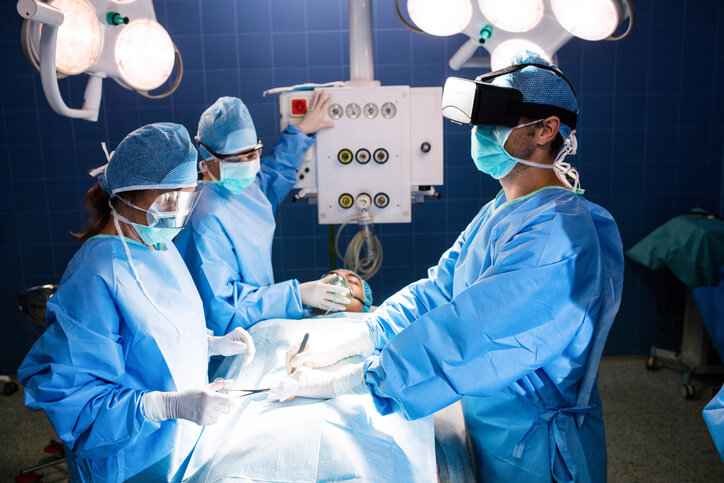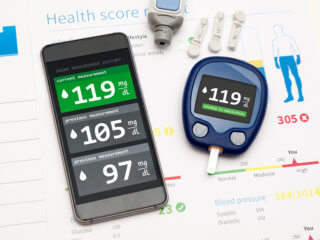Some of the great technological progressions of the last 25 years, from wearable technology to CT Scans, have primarily changed the way in which patients are analyzed and treated. They have also dramatically and significantly enhanced the way in which healthcare physicians and specialist are educated and trained. Augmented Reality in surgery is one of the most hopeful digital technologies currently – look at the achievement of VR – and it can change the healthcare and conventional pharmaceutical totally for doctors and patients alike.
What is the Augmented Reality? What are its advantages in surgery?
For patients, Augmented Reality can significantly improve the quality of treatment they receive from their healthcare provider. For freshers, the risks related to pure invasive surgery can be lessened by keeping the most vital data up front for the surgeon.
Earlier this type of surgery required monitor screens in the operation room to show significant images and stats being brought by an endoscopic camera. Now, because of AR, a medical surgeon can now wear smart glasses amid the procedure and remain focused on the job at hand, thus limiting mix-ups and diminishing the need to multitask more than required.
Besides, patient education immensely critical with regards to successful treatment and prevention. AR applications can be utilized to demonstrate the impact of diseases better, and it has been exhibited that a multi-sensory experience can be more viable in transmitting data. These apps can likewise help each patient’s close relative with regards to the lab reports and significances of conditions, making their influence to the well-being of patients and clients more useful than before.
| Recommended for you | |
| Virtual reality and augmented reality to train physicians | |
| Virtual reality in health care | |
| Virtual reality revolutionizes health care |
Examples of useful applications of Augmented Reality in surgery
The use of Augmented Reality in healthcare is two-fold for physician; first, there is the preparation and instruction viewpoint, permitting new doctors to lift their heads from their reading materials and better imagine the medical problems they will one day be treating; and second, the innovation will significantly improve their capacity to analyze and treat conditions by permitting them to access real-time information and patient data quicker than ever.
While it is of undoubted significance that comprehends the hypothesis behind surgical techniques, pathology, and human life systems, they should likewise understand the positive real-life consequences. Augmented Reality innovation permits medical training to considerably more able and prompt, helping trainee doctors rapidly join the dots from the hypothesis in their books and white papers to the real-world outcomes.
For example, applications can be utilized to overlay and show anatomical data on a 3D-printed human skeleton, permitting the student to reexamine the names of the bones, while offering a superior comprehension of how the human body works. What’s more, AR can even be utilized to add original and necessary components to the textbooks themselves. Rather than review a 2D design of the human heart, by just setting an AR application over the page in the book, this can turn into a 3D pulsating heart, with more detail than would ever be offered by a simple chart or photo.
Which companies and researchers are working on it?
In Canada, clinician’s associated with the University of Montreal have built up an expensive yet simple virtual reality test system, SIM-K, that shows young trainee doctors how to perform complex knee surgeries.
Presently, neurosurgeons at the Mayo Clinic, Ronald Reagan UCLA Medical Center, and other hospitals are planning their methodologies with virtual reality technology. They can virtually steer wearing Facebook’s Oculus Rift goggles through 3D models built from CT and MRI and scans—searching, for instance, for the path to a hard-to-reach tumor.
Bioflight VR is developing platforms for all the major VR gears including Samsung Gear VR, PlayStation VR, and Oculus Rift. Their platform is intended for medical training in Virtual Reality and the potential for doctors to be able to view CT and MRI data in Virtual Reality to change diagnostic procedures across the pharmaceutical industry.
The University of Alabama at Birmingham developed an augmented reality technology which surgeons can have their mentor join the operation virtually while it’s underway. Virtual Interactive Presence and Augmented Reality, uses Google Glass to overlay a projection of the instructor’s hands into the surgeon’s field of sight—from anywhere around the world.
AccuVein AV400 helps providers find patients’ veins more accurately for infusions. It displays a map of the vasculature digitally on the surface of the skin in real time, letting clinicians check vein patency and stay away from bifurcations or valves.
In Boston, doctors at Beth Israel Deaconess Medical Center have experimented with secured Google Glass goggles to overlay supportive clinical information as they talk and examine patients. The glasses are activated by a QR code outside the patient’s room and can extract in electronic health record ranging from lab results to nurses’ notes too.
How big is the Augmented reality in Surgery market?
The global market of Augmented reality is expected to reach a value of over 1.5 Billion USD by 2020. Augmented Reality has far-reaching achievements that will change the medical sector; from assistance during complicated surgical procedures and providing real-time data, to supporting post care and administration.
Goldman Sachs analyst Heather Bellini forecasts that AR and VR could easily make up to $80 Billion in revenue, by 2025. Facebook’s Mark Zuckerberg has set a $2 Billion investment on virtual reality using Oculus purchase in 2014. And Magic Leap, an augmented reality startup firm associated with Google, recently raised a handsome$4.5 Billion valuation.
What does the future look like?
Augmented Reality applications are among the most exciting and revolutionary technology available today, and the potential for medical applications is astounding. By utilizing this technology, doctors and patients alike can make more informed healthcare decisions, leading to a better quality of life and a better standard of care.
Augmented Reality endures to benefit the healthcare field, but there’s far more to be developed and discovered. From instruction to admin accurateness and even remote procedures, AR aids bridge detachments, ease distress and make small improvements along the way that lead to significant developments for both medical professionals and patients.
Image credit: www.istockphoto.com

















